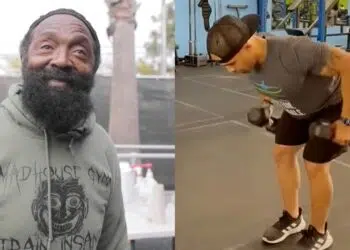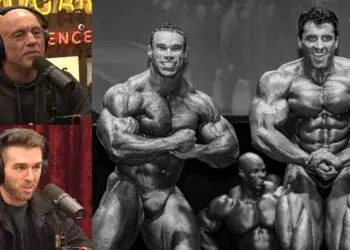Fitness expert Jeff Nippard‘s unbiased analysis about health and fitness practices is the only reason for his ever growing follower base and rightfully so. Recently, he took to his YouTube channel and spoke at length about his findings on popular methods of boosting metabolism.
Nippard is a Canadian natural bodybuilder, powerlifter and fitness expert. He is a well respected figure in the YouTube fitness community. The Canadian often delves deep into the scientific data pertaining to bodybuilding, health and fitness to enrich the knowledge of his followers.
Nippard was the 2012 Mr. Junior Canada title holder and also held the Canadian national record for bench press. Over the years, he has trained several natural bodybuilders and powerlifters in achieving their professional goals.
Nippard has addressed several critical issues like common dieting mistakes, most suitable training methods for busy individuals that cannot spend hours and hours in the gym through his content. He continues to impart knowledge and enrich his 3.79 million YouTube subscribers through insightful content.
Maintaining a healthy metabolic rate is a prerequisite to burn fat and stay in shape. While it is not a complicated job to boost metabolism by any stretch of imagination, the internet and fitness world is full of contradictory information. Exaggerated claims of certain dietary practices, training methods and lifestyle changes bombard us from all directions.
It is difficult but equally important to separate wheat from the chaff and find the stuff that is devoid of any personal motives or marketing ploy. Nippard recently shared his findings related to some of the most common ways of increasing the metabolic rate. So let’s check out what he concluded from studying all the scientific data.
Level Up Your Fitness: Join our 💪 strong community in Fitness Volt Newsletter. Get daily inspiration, expert-backed workouts, nutrition tips, the latest in strength sports, and the support you need to reach your goals. Subscribe for free!
Jeff Nippard analyses the efficacy of different methods for improving metabolism
Is Hydration the key to metabolic boost?
Drinking more water has always been linked with metabolic boost. But does it really have the same effect that is often claimed? Consuming one glass of water burns eight calories.
“Cold water gives a bigger boost than room temperature water because your body has to burn calories to heat the cold water up to body temperature.”
However, Nippard is sceptical about the prospects of substantial fat loss due to water loading. The reason? Burning those extra calories with drinking more water can be possibly compensated for.
“For example, you could drink more water but then subconsciously move around a little less so that the net (metabolic) boost cancels out, at least partially.”
“I’m also not a fan of forced drinking water. If you overdo it with ultra high water intakes within a short time frame, you can develop water intoxication or hyponatremia which can be dangerous.”
Generally speaking, Nippard advises drinking eight to twelve glasses or about two to three litres per day is plenty. More importantly, most people can use their internal thirst signals to guide their intake of water.
Some of the most hyped methods that do not yield expected returns in terms of metabolic boost
There is no miraculous solution to good health no matter what the bandwagon riders tell you. Things like, for example, green tea, have been the posterchild of metabolism boosters. Most of us have either heard someone speak about the potential benefits of drinking green tea for this purpose or have tried it ourselves. However, most studies don’t show any correlation between green tea and increased metabolism. There is no denying that you can get a small metabolic boost from consuming green tea. But it certainly does not yield any miraculous benefits that thousands of articles on the internet claim.
Sitting in Sauna and cold baths can have some benefits in terms of metabolic boost. For instance, sitting in a sauna for ten minutes can burn up to 19 calories. This is, but just a slight increase from sitting on the couch that burns approximately 14 calories in that time frame.
Similarly, cold baths do improve oxygen consumption of the body. But that does not translate into a significant metabolic boost by any stretch of imagination. Immersing yourself neck deep in cold water burns 28 calories in 10 minutes and does not promise any drastic change.
Dietary practices like eating spicy food and reverse dieting help but how much exactly?
A compound called capsaicin found in chillies has a thermogenic effect. It makes them most promising from the metabolic standpoint compared to other spices like ginger and garlic. While studies show that foods containing capsaicin can cause a metabolic boost of about 20 calories, it is nowhere near the levels people desire.
However, spicy foods are still effective in boosting metabolism. Nippard explained the reasons for this and said:
Level Up Your Fitness: Join our 💪 strong community in Fitness Volt Newsletter. Get daily inspiration, expert-backed workouts, nutrition tips, the latest in strength sports, and the support you need to reach your goals. Subscribe for free!
“I think the main reason spicy food can be helpful for weight loss is not because it can give a 20-calorie metabolic boost but rather that it can increase satiety and fullness. I find I eat more slowly and drink more water when I have a spicy meal and if that helps you eat less total calories for the day that could be helping drive fat loss.”
Other methods like reverse dieting and meal frequency claim to have great benefits in terms of boosting metabolism. However, Jeff Nippard admitted to not having studied reverse dieting extensively to make a foolproof claim about its efficacy. On the other hand, meal frequency has proven to make no change in the rate of metabolism in several studies.
Is there a potent method to boost metabolism?
Yes. Building muscle mass through a strength training program is probably one of the best ways to burn calories throughout the day. As you start gaining more muscle and shed fat along the way, the rate of metabolism also starts heading in the right direction. Scientific reason for this? Nippard explained:
“At rest, one pound of fat burns about two calories per day while one pound of muscle burns about six calories per day.”
The cumulative effect of these numbers could change the entire ball game when applied to an adult male’s physique. For instance, when the calculation is applied to a person with Jeff Nippard’s body composition, the body fat would burn 24 calories while the muscle mass would burn a whopping 480 calories.
Effect of cardio on metabolism
If strength training and muscle building is so effective, how would cardio fare in this test? Afterall, calorie expenditure and metabolic boost are two of the most impressive benefits of cardio exercises, aren’t they?
Well, it turns out that’s not quite the case. Cardio is certainly a great way to improve circulation and build cardiovascular strength. It also burns a hell lot of calories but tends to offset the metabolism by compensating through other means.
“When you burn more calories through cardio, your body subconsciously burns less calories through NEAT – non-exercise activity thermogenesis. This is the component of metabolism that includes activities other than exercise. So stuff like fidgeting and bobbing your head to music,” Nippard added.
He further explained that the body senses the cardio activity and subconsciously. It then reduces NEAT so the total energy expenditure is relatively lesser on that particular day. While there is a significant amount of difference in the way this phenomenon works on each individual, Nippard explained:
“On average for every 100 calories you burn by doing cardio, you’ll only actually increase your daily energy expenditure by 72 calories.”
However, cardio is still an effective way to boost metabolism. Even if it is not as effective as strength training and muscle building, it could be the second best.
Using weighted vest
Wearing a weighted vest has also shown to help in this regard. It has a pretty cool science behind it. The way Jeff Nippard explained it:
“The general idea is if I weigh 160 lbs right now and I start wearing a 20 lbs weighted vest, my body starts to think that I weigh 180 lbs and burns calories like a 180 lbs person would. Recent evidence has suggested the existence of a system of sensors in the body called the gravitastat which senses changes in loading on the bones. If these sensors get the idea that you are now a heavier person, it will increase your caloric expenditure and decrease hunger levels.”
Weighted vests probably work effectively but it is a relatively new phenomenon. As a result, there has to be more research to prove conclusively that they do, in fact, work.
Jeff Nippard has simplified an important aspect of fitness through the findings in this video. So now that you know what works for sure to increase metabolism, it should he easy to make the necessary changes to your lifestyle.
You can watch the full video here, courtesy of Jeff Nippard’s personal YouTube channel:









